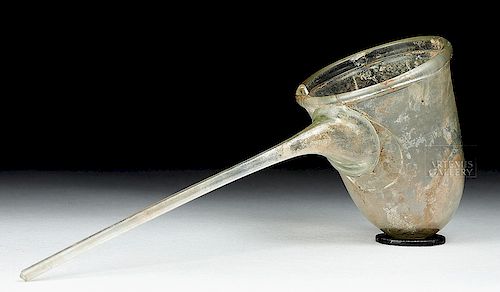Ancient Islamic Glass Alembic for Medical Cupping
Lot 97
About Seller
Artemis Fine Arts
686 S Taylor Ave, Ste 106
Louisville, CO 80027
United States
Selling antiquities, ancient and ethnographic art online since 1993, Artemis Gallery specializes in Classical Antiquities (Egyptian, Greek, Roman, Near Eastern), Asian, Pre-Columbian, African / Tribal / Oceanographic art. Our extensive inventory includes pottery, stone, metal, wood, glass and textil...Read more
Categories
Estimate:
$800 - $1,200
Absentee vs Live bid
Two ways to bid:
- Leave a max absentee bid and the platform will bid on your behalf up to your maximum bid during the live auction.
- Bid live during the auction and your bids will be submitted real-time to the auctioneer.
Bid Increments
| Price | Bid Increment |
|---|---|
| $0 | $25 |
| $300 | $50 |
| $1,000 | $100 |
| $2,000 | $250 |
| $5,000 | $500 |
| $10,000 | $1,000 |
| $20,000 | $2,500 |
| $50,000 | $5,000 |
| $100,000 | $10,000 |
| $200,000 | $20,000 |
About Auction
By Artemis Fine Arts
May 10, 2018
Set Reminder
2018-05-10 10:00:00
2018-05-10 10:00:00
America/New_York
Bidsquare
Bidsquare : Fine Ethnographic / Asian / Ancient Art
https://www.bidsquare.com/auctions/artemis-gallery/fine-ethnographic-asian-ancient-art-3213
Featuring antiquities from around the world including Pre-Columbian, Tribal, Classical, Asian, so much more! Artemis Fine Arts info@artemisfinearts.com
Featuring antiquities from around the world including Pre-Columbian, Tribal, Classical, Asian, so much more! Artemis Fine Arts info@artemisfinearts.com
- Lot Description
Ancient Near East, Islamic, ca. 6th to 12th century CE. A special example of a glass vessel form that has been understudied - an alembic, funneled cup, or cupping glass - presenting a deep-hemispheric body with a rolled rim and a long stem handle, all comprised of translucent glass. The name alembic is derived from the Arabic word al-anbiq (to still) and the Greek word ambix (cup). Scholars have suggested three uses for alembics - medical, chemical, or feeding. Given their small size, the ancients could more easily feed their babies small doses of medicine or food. In addition, according to an Arabic source of medical literature entitled "al-Tasrif" by Abu al-Qasim al-Zahrawi (936-1030), cupping vessels like this example were sometimes used to suction air from a patient's body. In addition, alembics are believed to have been used in the distillation process in order to create perfume or for magical alchemy. Size: 6.25" L (15.9 cm) from handle to cup edge; cup measures 1.75" in diameter (4.4 cm)
Source: For more about this intriguing form, read the following article entitled, "Searching for the Original Use of a Mysterious Glass Vessel" by Barbara Venezia (a former intern of the Department of Islamic Art, Metropolitan Museum of Art) August 24, 2016 - https://www.metmuseum.org/blogs/ruminations/2016/alembics
Provenance: private Davis collection, Houston, Texas, USA; ex-Gerhard Hirsch Nachfolger Auction 277-278, Munich, Germany, lot 513
All items legal to buy/sell under U.S. Statute covering cultural patrimony Code 2600, CHAPTER 14, and are guaranteed to be as described or your money back.
A Certificate of Authenticity will accompany all winning bids.
We ship worldwide and handle all shipping in-house for your convenience.
#132758Loss to tip of handle. Handle reattached, showing surrounding break line and radiating fissures. Earth deposits on interior.Condition
- Shipping Info
-
All shipping is handled in-house for your convenience. Your invoice from Artemis Gallery will include shipping calculation instructions. If in doubt, please inquire BEFORE bidding for estimated shipping costs for individual items.
-
- Buyer's Premium



 EUR
EUR CAD
CAD AUD
AUD GBP
GBP MXN
MXN HKD
HKD CNY
CNY MYR
MYR SEK
SEK SGD
SGD CHF
CHF THB
THB

















